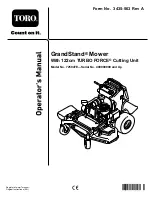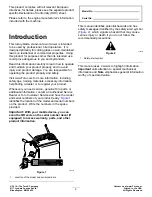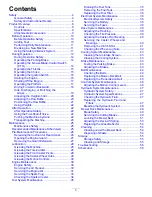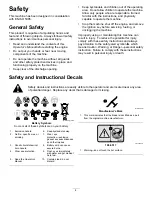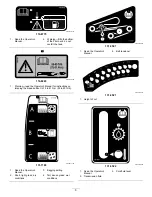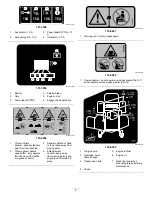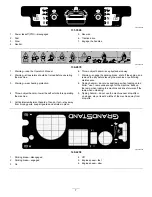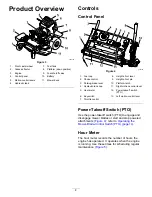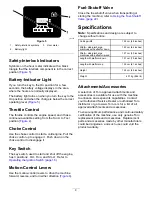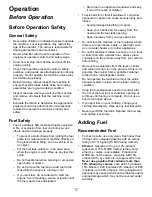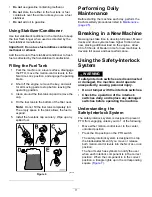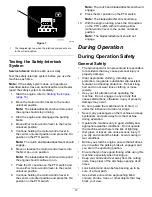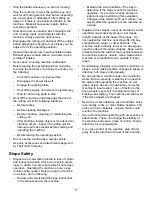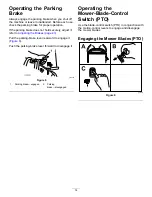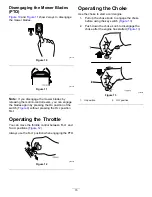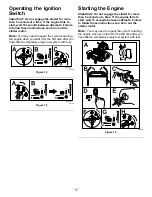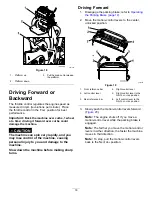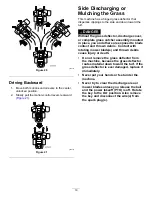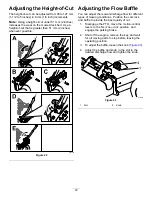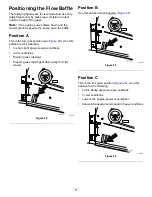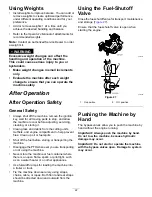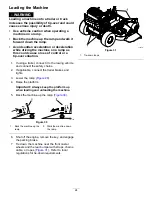
Operation
Before Operation
Before Operation Safety
General Safety
•
Never allow children or untrained people to operate
the machine. Local regulations may restrict the
age of the operator. The owner is responsible for
training all operators and mechanics.
•
Become familiar with the safe operation of the
equipment, operator controls, and safety signs.
•
Know how to stop the machine and shut off the
engine quickly.
•
Check that operator-presence controls, safety
switches, and guards are attached and functioning
properly. Do not operate the machine unless they
are functioning properly.
•
Before mowing, always inspect the machine to
ensure that the blades, blade bolts, and cutting
assemblies are in good working condition.
•
Inspect the area where you will use the machine
and remove all objects that the machine could
throw.
•
Evaluate the terrain to determine the appropriate
equipment and any attachments or accessories
required to operate the machine properly and
safely.
Fuel Safety
•
Fuel is extremely flammable and highly explosive.
A fire or explosion from fuel can burn you and
others and can damage property.
– To prevent a static charge from igniting the fuel,
place the container and/or machine directly on
the ground before filling, not in a vehicle or on
an object.
– Fill the fuel tank outdoors, in an open area,
when the engine is cold. Wipe up any fuel that
spills.
– Do not handle fuel when smoking or around an
open flame or sparks.
– Do not remove the fuel cap or add fuel to the
tank while the engine is running or hot.
– If you spill fuel, do not attempt to start the
engine. Avoid creating a source of ignition until
the fuel vapors have dissipated.
– Store fuel in an approved container and keep
it out of the reach of children.
•
Fuel is harmful or fatal if swallowed. Long-term
exposure to vapors can cause serious injury and
illness.
– Avoid prolonged breathing of vapors.
– Keep your hands and face away from the
nozzle and the fuel-tank opening.
– Keep fuel away from your eyes and skin.
•
Do not store the machine or fuel container where
there is an open flame, spark, or pilot light, such
as on a water heater or on other appliances.
•
Do not fill containers inside a vehicle or on a truck
or trailer bed with a plastic liner. Always place
containers on the ground, away from your vehicle
before filling.
•
Remove the equipment from the truck or trailer
and refuel it while it is on the ground. If this is not
possible, then refuel from a portable container
rather than a fuel-dispenser nozzle.
•
Do not operate the machine without the entire
exhaust system in place and in proper working
condition.
•
Keep the fuel-dispenser nozzle in contact with
the rim of the fuel tank or container opening at
all times until fueling is complete. Do not use a
nozzle lock-open device.
•
If you spill fuel on your clothing, change your
clothing immediately. Wipe up any fuel that spills.
•
Never overfill the fuel tank. Replace the fuel cap
and tighten it securely.
Adding Fuel
Recommended Fuel
•
For best results, use only clean, fresh (less than
30 days old), unleaded gasoline with an octane
rating of 87 or higher ((R+M)/2 rating method).
•
Ethanol
: Gasoline with up to 10% ethanol
(gasohol) or 15% MTBE (methyl tertiary butyl
ether) by volume is acceptable. Ethanol and
MTBE are not the same. Gasoline with 15%
ethanol (E15) by volume is not approved for use.
Never use gasoline that contains more than
10% ethanol by volume
, such as E15 (contains
15% ethanol), E20 (contains 20% ethanol), or E85
(contains up to 85% ethanol). Using unapproved
gasoline may cause performance problems and/or
engine damage which may not be covered under
warranty.
10
Summary of Contents for GrandStand 72504TE
Page 58: ...Schematics g302050 Electrical Schematic 140 1878 Rev A 58 ...
Page 59: ...Notes ...

